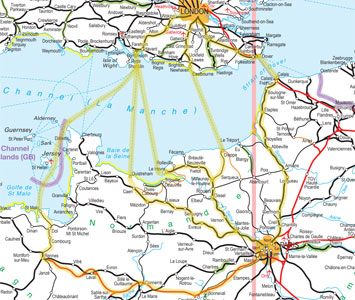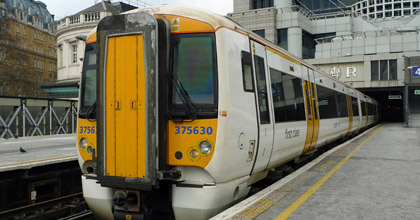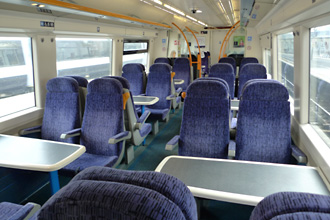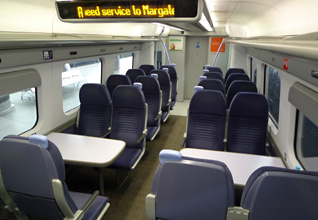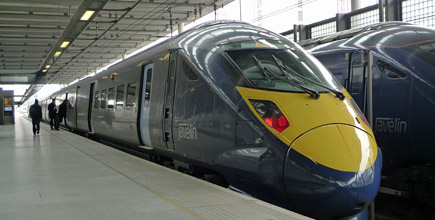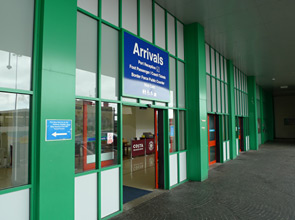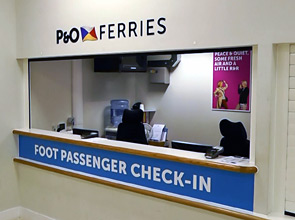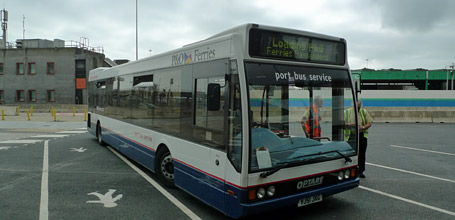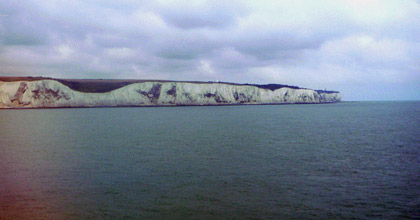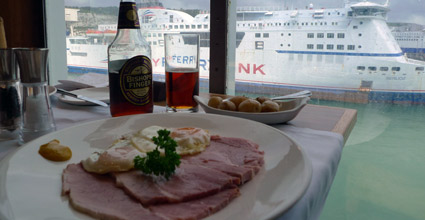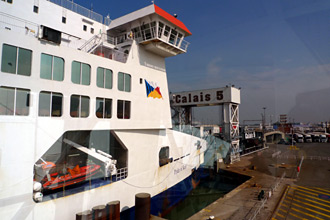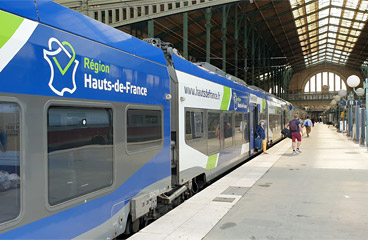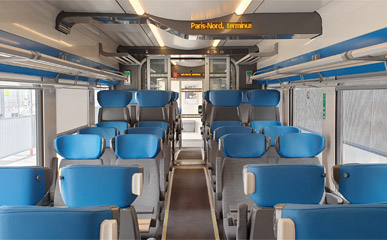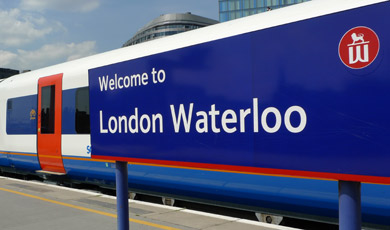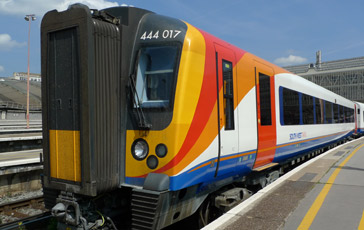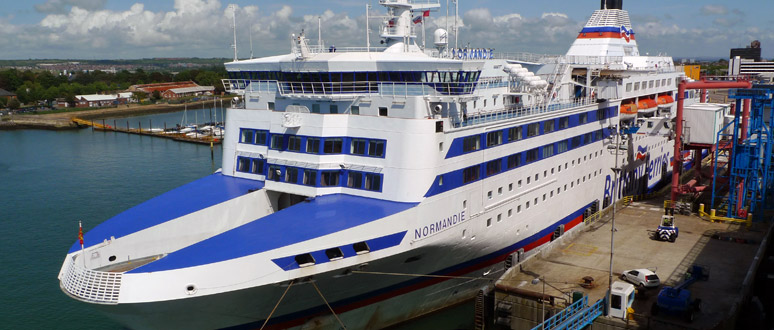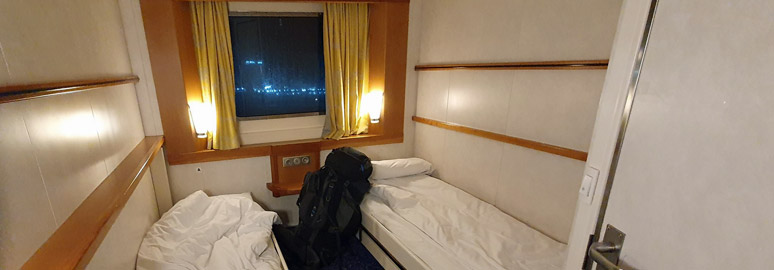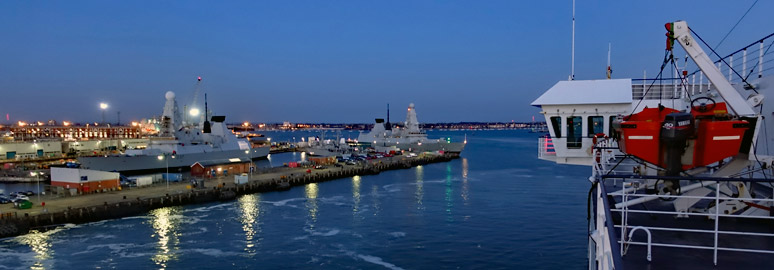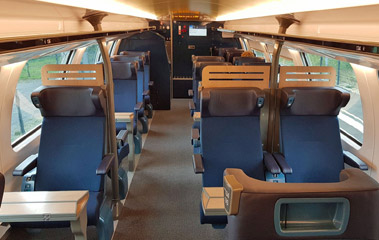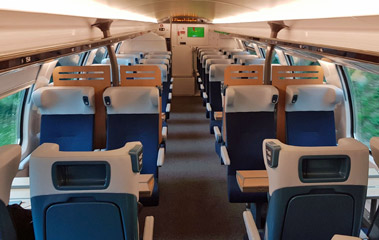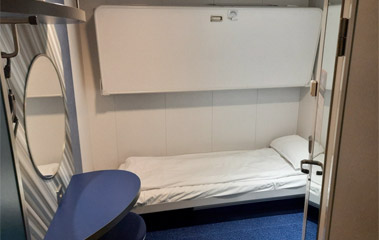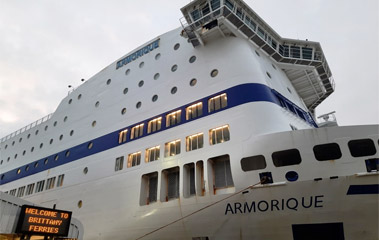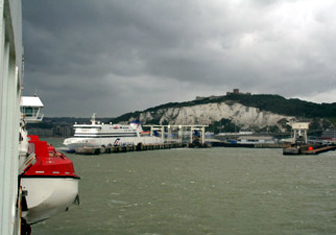 |
|
|
White Cliffs of Dover... Returning from France the ferry approaches Dover Eastern Docks, with Dover Castle above the White Cliffs. |
The ferry alternatives to Eurostar
|
|
|
|
|
London to Paris via Dover-Calais - shortest crossing, fastest journey |
|
|
London to Paris via Newhaven-Dieppe - slower, slightly cheaper, easier transfer in Newhaven |
|
|
London to Paris via Portsmouth-Caen - the comfortable 'sleeper' option with private cabin |
|
|
London to Paris via Portsmouth-St Malo - a more leisurely 'sleeper' option |
Why go by train & ferry?
High-speed Eurostar trains link London & Paris in just 2h20 from £52 one-way or £78 return. But you can still travel from London to Paris by train-ferry-train, and there are several reasons why you might want to:
-
You want to re-create the classic train & ferry experience, via the White Cliffs of Dover.
-
You want to avoid the Channel Tunnel, for example due to claustrophobia - although you'll find the Channel Tunnel is a complete anti-climax, it's just 20 short minutes out of a 2¼ hour Eurostar journey and feels like any other railway tunnel, just a bit longer.
-
You need to travel at short notice, when Eurostar is expensive or fully-booked or there's some sort of problem with the Tunnel.
First a reality check
-
London to Paris takes around 11 hours by train-ferry-train, Eurostar takes just 2h15.
-
Train & ferry usually costs more than Eurostar, we're talking £97 one-way in total, when Eurostar starts at £52 if you book a few months in advance. Only at short notice, when Eurostar fares rise like air fares to as much as £200 will train & ferry be cheaper.
-
The railway stations at Dover Western Docks and Calais Maritime closed when Eurostar started in 1994, so you can no longer simply walk off the train and onto the ferry as you used to. The journey now involves a taxi or long walk between the station and the ferry terminal in Dover and a bus or taxi in Calais, so a train-ferry-train journey that took only 7 or 8 hours in the 1930s (or for that matter, the 1980s) takes 11 hours today. Watch the video guide.
-
You need to buy separate tickets for the British train, ferry & French train, because London to Paris through tickets ceased to exist in 2007.
-
If you are travelling to Switzerland, Italy, the Netherlands, Germany, Austria, Eastern Europe or Scandinavia, and want an alternative to Eurostar avoiding the Channel Tunnel, I strongly recommend the vastly superior integrated train-ferry-train service from London Liverpool Street via Harwich and Hoek van Holland, with trains arriving directly at the ferry terminals and integrated ticketing, see the London to Amsterdam Rail & Sail page for details.
But on the plus side
-
You get to travel across Kent on a more scenic and historic route at a slower pace, assuming you choose one of the two classic routes from Victoria or Charing Cross to Dover;
-
You get to sail across the English Channel with the White Cliffs of Dover disappearing astern, with restaurants and bars available on board;
-
You don't have to go through the Channel Tunnel if that's a big issue for you;
-
The trains & ferries offer a 'walk up, buy a ticket and hop on' service, with no reservation or advance booking necessary, so the cost can be less than Eurostar if you need to travel at short notice. It doesn't all need to be booked in advance like Eurostar!
Which route to choose?
-
Dover-Calais: The traditional & fastest option, with the shortest sea crossing, via the traditional White Cliffs of Dover. Unfortunately (and incredibly), only 3 sailings a day currently accept foot passengers. Click for details.
-
Newhaven-Dieppe: Also a traditional rail-sea-rail route, in fact a more direct one between London & Paris. However, with a longer sea crossing, Newhaven-Dieppe always played second-fiddle to Dover-Calais. These days, it can be cheaper than via Dover, all sailings take foot passengers and the station-ferry transfers are a lot easier, too. Click for details.
-
Portsmouth to Caen: The comfortable overnight 'sleeper' option. Leave London Waterloo at 18:30, sleep in a comfortable en suite cabin on an overnight ferry 22:45-06:45, then take a train to Paris St Lazare next morning arriving around 11:05. Click for details.
-
Portsmouth to St Malo: A more leisurely and luxurious overnight 'sleeper' option.
Route map
London to Paris via Dover-Calais
The route via Dover-Calais is the traditional one with the shortest sea crossing.
Below is an example timetable, using the classic train route from London Charing Cross to Dover, P&O ferries from Dover to Calais (the only company that carries foot passengers at all), and the classic route from Calais to Paris via Boulogne & Amiens.
Unfortunately, only designated P&O ferry sailings now take foot passengers and you need to allow plenty of time for lengthy station-port transfers plus P&O's ridiculous 90-minute ferry check-in for foot passengers. So the journey now takes around 11 hours, when it only took 7 or 8 hours in the 1930s.
I compiled the timetable below around the handful of sailings shown as carrying foot passengers at the time I wrote this, but P&O occasionally switch these sailings around, so first check foot passenger sailing times at www.poferries.com for your specific date, then work out connecting train times in Britain and in France, as explained below.
c = change at Amiens
How to read these timetables. No UK trains run on these routes on 25 or 26 December. Watch the video guide.
How to check times for your date of travel
-
Step 1, start by checking French train times from Calais to Paris as this is the least frequent part of the journey, using www.thetrainline.com.
-
Step 2, then work backwards, looking for a ferry at www.poferries.com which carries foot passengers and which arrives at Calais ferry terminal at least 90 minutes before the train leaves Calais Ville, preferably 2 hours.
-
Step 3, now look for a London to Dover train at www.thetrainline.com which arrives at Dover Priory at least 2 hours before the ferry sails.
-
Unlike the integrated pre-Eurostar train+ferry services, this is not an organised service where ferries are held if trains run late, but completely separate trains and ferry. If you have important connections in Paris, bear this in mind and take an earlier train from London.
Step 1, London to Dover by train
-
Which route to choose? There are three routes from London to Dover to choose from, two classic and one high-speed:
(1) The classic South Eastern Railway route from London Charing Cross via Tonbridge & Folkestone, every hour, journey around 1h50.
(2) The classic London, Chatham & Dover Railway route from London Victoria via Chatham & Canterbury, every half hour, journey around 1h55.
(3) The modern high-speed route leaving from London St Pancras, direct trains every hour, journey time 1h08.
You can check UK train times & fares for all these routes at www.nationalrail.co.uk or at any train operator website such as tfw.wales. In the timetable above I show the classic Charing Cross to Dover route via Tonbridge.
The high-speed trains from London St Pancras to Dover Priory are significantly faster, but are more expensive & less scenic. They use the modern high-speed line opened in 2007. The scenery is much nicer along the two classic 19th century lines.
-
Historical note:
If you're trying to recreate the classic 'boat train' experience, you should take one of the two classic 19th century railway routes, the South Eastern Railway from Charing Cross to Dover via Tonbridge, Ashford & Folkestone or the London, Chatham & Dover Railway via Chatham, Faversham & Canterbury. Pre-1994, the non-stop 'boat trains' would have left from Victoria, but between Bromley & Orpington they usually switched to the line via Tonbridge & Ashford used by trains out of Charing Cross, known as Boat Train Route 1.
If you use the classic route from Charing Cross to Dover as shown in the timetable above, you'll cross the bridge over the River Beult between Staplehurst & Headcorn where Charles Dickens' boat train from Folkestone to London came to grief in 1865. There are in fact 3 such bridges between Headcorn & Staplehurst, the River Beult A, B & C bridges. The accident happened on the 'A' bridge closest to Staplehurst.
-
How much does the train cost?
London-Dover by classic route costs £50.50 Anytime one-way, £101.00 Anytime 1 month return.
Or if travelling at weekends or after 09:30 weekdays: £34.90 Super-Off-Peak one-way or £48.70 Off-Peak one month return.
-
What train should you take?
To reach Paris the same day, you'll need to leave London fairly early and build your timings around the relatively infrequent French trains between Calais & Paris, see the example timetable above to visualise how train, ferry and train fit together and work out train, ferry & train timings for your specific date as explained here. If you're only travelling as far as Calais or Boulogne or somewhere like Etaples, no problem as long as you leave by lunchtime or so, as London-Dover trains run every half hour, ferries sail to Calais every hour or two, and French local trains link Calais and Boulogne at least every hour.
-
How to buy tickets
No reservation is necessary or possible for London-Dover trains, tickets cannot sell out and the fare is the same whenever you buy your ticket. Just turn up and buy a train ticket to Dover on the day at the station.
The classic option: An express to Dover waits to leave Charing Cross.
The high-speed option: A train from London St Pancras to Dover.
Step 2, transfer from station to port in Dover
-
Allow at least 2 hours in Dover between your train arrival and planned ferry departure, ideally more, it's a 5-10 minute taxi ride to the ferry terminal and there's a whopping 90-minute minimum check-in for the ferry.
-
When you arrive at Dover Priory station, walk or take a taxi to the P&O passenger terminal at Dover Eastern Docks.
It's 1.3 miles, a 29 minute walk, see walking map. It's only a 5-10 minute taxi ride, there are usually plenty of taxis waiting at Dover Priory station, a taxi costs around £8. There's no bus between station and port, P&O stopped their shuttle bus back in 2014.
When the taxi drops you at the Eastern Docks passenger terminal, go into the door marked Arrivals as this is foot passenger departures. Go to the P&O Ferries desk to buy a ticket or if you already have a ticket, check in and get your boarding card.
-
Just under 90 minutes before each ferry sails, a P&O courtesy bus leaves from the terminal building taking foot passengers to the ferry. The bus stops for passport checks and possibly a random baggage security screening, then drives onto the ferry car deck, with lifts & stairs up to the passenger decks. You keep all your bags with you throughout the journey.
-
Historical note: Pre-1994, boat trains would run to Dover Western Docks station (called Dover Marine until 1979) at the western end of Dover's sea front, to connect with ferries to Calais or Boulogne. You just walked off the train, through customs and up a gangplank onto the ferry, so convenient. Dover Western Docks station closed when Eurostar started in 1994 and it's now a car park for Dover's cruise terminal. All ferries now leave from the pedestrian-hostile Dover Eastern Docks at the eastern end of the sea front, developed for car ferries from the 1950s onwards.
Step 3, Dover to Calais by ferry
-
P&O Ferries sail from Dover Eastern Docks to Calais roughly every hour, crossing time 1h40, though they often leave with a 10-20 minute delay. P&O are the only operator on this route who accept foot passengers, others don't - and only a designated sailings take foot passengers. All ferries are now conventional ships, there are no longer any hovercraft or seacats.
-
How much does the ferry cost?
A Dover-Calais foot passenger ticket costs £30 each way if you buy a Saver fare online at www.poferries.com.
-
How to buy tickets
You should buy your ferry ticket online at www.poferries.com.
You can buy on the day at the ferry terminal if you really need to, but it costs more and places aren't guaranteed.
Sailing across the Channel with the White Cliffs of Dover disappearing astern.
A great day for a Channel crossing, with views of Dover's famous White Cliffs.
Step 4, transfer from port to station in Calais
-
Take the transfer bus from the ferry to the port terminal building.
The ferry will arrive at one of the many berths at Calais Maritime ferry terminal. Passengers are shuttled from the ferry to the terminal building by P&O courtesy bus.
Make sure you allow at least 90 minutes in Calais between the ferry arrival and the departure of the train to Paris, preferably more.
-
Take the free bus from the terminal building to Calais town centre & Calais Ville station.
The best way from the ferry terminal building to Calais town centre or Calais Ville station is using the free Balad’in bus. This runs every 22 minutes in the morning, every 11 minutes in the afternoon, on Mondays-Saturdays only. On Sundays, use a taxi or walk.
-
Or take a taxi
You can take a taxi, although you may need to ask staff inside the terminal to call one for you as there may be none waiting. Journey time 15 minutes, but you may have to wait for a taxi to be sent.
-
Or walk
It's possible to walk into town, there is pavement all the way, but it's a long and unattractive walk now that a new terminal building has opened even further out of town. It takes 49 minutes to walk the 3.8 km from the new ferry terminal to Calais Ville station, a little less to the town centre. See map showing walking route.
-
Historical note: Until 1994 there was a station called Calais Maritime at the ferry terminal. The station building is still there, I believe, closer to the actual ferry berths than the modern terminal building shown below. Until 1994 you could just walk off the ferry, through customs, and onto a train to Paris. The tracks are long gone, and it requires two buses to get you to a train at Calais's town centre station, Calais Ville.
Above, Calais ferry terminal, opened in 2021 and even further out of town than the original one. A free bus runs to the town centre & Calais Ville station Monday-Saturday, on Sunday you'll need a taxi. Courtesy of Andrew Turnbull.
Step 5, Calais to Paris by train
-
Every 2-4 hours, a modern air-conditioned TER regional train runs from Calais Ville to Boulogne Ville, Etaples, Amiens & Paris Gare du Nord. 2nd class only. You can check times at either www.thetrainline.com or www.sncf-connect.com.
-
There are relatively few trains between Calais & Paris, so it is usually the timings of these few trains which (working backwards) determines which ferry you need to take from Dover and therefore which train you need to take from London, see the example timetable above and see how to work out times for your specific date.
-
The Calais-Boulogne-Amiens-Paris line is the classic 'boat train' route and it's also the cheapest route, although you'll find other Calais-Paris options via Lille or Hazebrouck using TGV high-speed trains which require reservation and can be relatively expensive if not booked in advance.
-
How much does the French train cost?
Calais to Paris costs €43.60 one-way. This is the fixed-price tarif normal, you can just turn up and buy a ticket at this price on the day.
-
How to check train times & buy tickets:
You can check French train times & fares and buy tickets online at www.thetrainline.com (easy to use, small booking fee) or www.sncf-connect.com (a bit more fiddly). To specify a journey via the classic route through Boulogne and Amiens, use www.thetrainline.com, enter Calais Ville as your starting station, look for the via link and enter Amiens as a via station. The TER trains on the route via Boulogne & Amiens don't need to be reserved, indeed seat reservation is neither necessary nor possible, so you can always just turn up, buy a ticket at the station and hop on the next train. They cannot 'sell out'.
These new air-conditioned regional trains now run direct from Calais to Paris Gare du Nord. 2nd class only. They are bi-mode, capable of running on diesel (Calais-Amiens) and electric power (Amiens-Paris). Courtesy of Nicholas A Milligan.
Arrived at Paris Gare du Nord. See Paris Nord station guide. Courtesy of Nicholas A Milligan.
London to Paris via Newhaven-Dieppe
London to Paris for £97 one-way, even for immediate departure
The slower Newhaven-Dieppe route has always played second fiddle to the faster Dover-Calais route shown above, but these days it's worth considering because it's significantly cheaper, and the train-ferry transfer in Newhaven is much easier than in Dover. This is also the ideal route if you live in Brighton, as there are direct trains from Brighton to Newhaven Town every half hour, taking 30 minutes.
This is an example timetable, DFDS tweak sailing times throughout the year. So use this as a guide. To find times for your date of travel, first check ferry times at www.dfds.com, then find suitable UK connecting trains arriving at Newhaven at least 1h30 before the ferry sails using www.nationalrail.co.uk. Then find a suitable French connecting train leaving at least 1 hour after arrival using www.sncf-connect.com or www.thetrainline.com.
* = On Saturday mornings, depart Dieppe 07:00, change Rouen, arrive Paris 09:23.
e = change trains at Lewes. b = change at Brighton. c = change at East Croydon & Brighton. An underlined time means change trains.
In Newhaven, get off at Newhaven Town station and walk 300m to the ferry terminal, see walking route. You check in any large bags and get them back at Dieppe.
In Dieppe, a shuttle bus run by the Grisel bus company links the ferry terminal and SNCF station in connection with each sailing, fare €3, or it's a 30-minute 2.4 km walk, see walking route. Or there are taxis.
Important: As with the Calais timetable, I wont keep this page 100% updated with every minor ferry sailing time change. So use it as a guide, check ferry times at www.dfds.com then find suitable connecting trains at www.nationalrail.co.uk for the UK side and at www.sncf-connect.com for the French side.
How much does it cost?
-
London to Newhaven Town costs £38.90 one-way in the morning peak or £37.30 off-peak, bought at the station on the day.
-
Newhaven to Dieppe costs £20 each way as a foot passenger (£25 on Friday nights).
-
Dieppe to Paris costs €46.00 full price, bought on the day at the station, or from €15 pre-booked.
-
So you can travel from London to Paris for around £97, even at short notice.
-
You can book a cabin with toilet & shower on the ferry, around £60 per cabin with up to 4 berths.
How to buy tickets
- Buy your London-Newhaven train ticket at the station on the day, no reservation necessary or possible, it cannot sell out. You can check prices at www.nationalrail.co.uk or at any train operator website such as tfw.wales.
- Buy your ferry ticket online at www.dfds.com or at the port. There are almost always places available.
- Buy your Dieppe-Paris train ticket at the station, no reservation necessary, it cannot sell out, or save a few euros by pre-booking online at www.thetrainline.com (easy to use, in €, £ or $, small booking fee) or www.sncf-connect.com (a bit more fiddly, but no fee).
London to Paris via Portsmouth - Caen
The London-Paris 'sleeper' option
This is the overnight 'sleeper' option, where you leave central London early evening, have a decent night's sleep in a comfortable cabin with en suite shower & toilet on the overnight ferry, and arrive in Paris by train next morning. A time-effective and comfortable alternative to Eurostar if you need one.
The Man in Seat 61 says "Brittany Ferries ships are comfortable, luxurious even, with cosy cabins, bars & restaurants. Sailing out of Portsmouth past the naval dockyard and the historic HMS Victory and HMS warrior is always a treat."
London & Portsmouth ► Caen & Paris
-
Step 1, travel from London to Portsmouth by train, leaving around 18:30.
You'll usually find a train leaving London Waterloo at 18:30 arriving Portsmouth & Southsea around 20:06.
London-Portsmouth trains run every half hour, check ferry times first, then use www.nationalrail.co.uk or any train operator website such as tfw.wales to find a train which arrives in Portsmouth & Southsea at least 2 hours before the ferry sails.
Transfer from Portsmouth & Southsea station to Portsmouth Continental Ferry Port by bus or taxi, remembering the 60-minute ferry check-in. A taxi takes 10 minutes and costs around £11. City buses run regularly, check times, bus numbers & bus stops at www.firstbus.co.uk.
-
Step 2, sail from Portsmouth to Caen with Brittany Ferries, usually sailing around 22:45 every day, arriving at Caen 06:45.
This route is normally operated by the 35,592-ton Mont St Michel and the 27,542-ton Normandie, with restaurants, bars & cosy cabins, all with toilet & shower. These large & steady ships mean a smooth crossing.
Sailing times vary, so check them at www.brittany-ferries.co.uk before booking any trains. On some dates the ship sails at 21:30, so you'll need to leave London earlier, around 17:00.
The ferry arrives at Ouistreham, 17 km from Caen. Transfer to Caen station by bus or taxi:
A taxi takes 20 minutes & costs around €30 during the day (07:00-19:00) or €40 at night. There are usually taxis waiting outside the terminal for ship arrivals, but if there are no taxis, the tourist information desk can call a taxi for you.
Buses are run by TWISTO, www.twisto.fr. The bus route is 12EX (or bus 12 on a few departures), buses leave from a stop called Ouistreham Port located 500m from the ferry terminal and go directly to Caen Gare SNCF, journey time 31-38 minutes by bus 12EX, 57 minutes by bus 12, fare around €1.60.
-
Step 3, travel from Caen to Paris by train, arriving around 11:04.
Allow at least 2h between ferry arrival and train departure. You'll usually find a train leaving Caen around 09:06 arriving Paris St Lazare around 11:04, but times vary so check them at www.thetrainline.com or www.sncf-connect.com.
Paris & Caen ► Portsmouth & London
-
Step 1, travel from Paris to Caen by train, leaving Paris around 17:59.
When the ferry sails at 23:00, you'll usually find a train leaving Paris St Lazare around 17:59 arriving Caen around 20:02, but times vary so check them at www.thetrainline.com or www.sncf-connect.com.
Always check ferry times first, then look up a train which gives you around 2½ hours between train arrival & ferry sailing time, this includes the 60-minute ferry check-in.
Transfer from Caen station to the ferry terminal at Ouistreham by bus or taxi.
A taxi takes 20 minutes & costs around €30 during the day (07:00-19:00) or €40 at night (after 19:00) for the 17 km. There will be plenty of taxis waiting outside the station.
Buses are run by TWISTO, check times at www.twisto.fr. The bus route is 12EX, the fare is around €1.80, you pay in cash on the bus or can use the TWISTO app. Buses leave from outside Caen Gare SNCF. Get off the bus at the Ouistreham Port stop located 500m from the ferry terminal, journey time 31 minutes. However, the last bus leaves Caen Gare SNCF at around 20:00-20:10, so you'll need to take an earlier train if you want to use the bus, one usually leaves Paris St Lazare around 17:09.
Tip: There are two route 12s from Caen, one run by NOMAD, the other run by TWISTO, you want the one run by TWISTO. That comes in two flavours, express & regular, the express is (obviously) faster, but both go to Ouistreham Port.
-
Step 2, sail from Caen to Portsmouth overnight with Brittany Ferries, usually sailing at 23:00 and arriving at 06:45.
Sailing times vary, so check them at www.brittany-ferries.co.uk before booking any trains. You'll find an overnight ferry most nights of the year, although not every night in winter. This route is normally operated by the Mont St Michel and the Normandie, with restaurants, bars & cosy cabins, all with toilet & shower.
-
Step 3, travel from Portsmouth to London by train arriving around 09:55.
Transfer from Portsmouth Continental Ferry Port to Portsmouth & Southsea station by bus or taxi. A taxi takes 10 minutes & costs around £11. City buses run regularly, check times, bus numbers & bus stops at www.firstbus.co.uk.
Assuming the ferry arrives at 06:45 on your date, you can easily make a train around 08:20 arriving London Waterloo around 09:55 - trains run regularly, at least every half hour. Check train times at www.nationalrail.co.uk.
How much does it cost?
-
London to Portsmouth by train costs £41.80 one-way or £55.00 one-month return if you turn up and buy on the day and buy an Off-peak ticket good for any off-peak train, no reservation needed.
If you book in advance and commit to a specific train, limited-availability Advance fares start from as little as £11.50 each way.
-
Portsmouth to Caen with Brittany Ferries costs from £35 each way for a foot passenger, rising up to perhaps £59 for immediate departure. 2-bed cabins with shower & toilet start at £39 per cabin booked well ahead, perhaps £69 for a 2-berth booked at shorter notice.
-
Caen to Paris by train costs €49.80 full-flex in 2nd class bought on the day, or from €15 with a cheap prems fare if you pre-book well in advance. 1st class costs €72.10 full-flex bought on the day or from €20 upwards if booked in advance.
How to buy tickets
-
Book the ferry first, at www.brittany-ferries.co.uk or use www.directferries.co.uk.
-
Then buy a London to Portsmouth train ticket at www.thetrainline.com (small fee) or using any train operator website such as tfw.wales (no fee). You print your own ticket or you can select mobile ticket and show it on your phone. If you're happy paying an Off-Peak or Anytime fare, you can buy at the station on the day.
-
Then buy a train ticket from Caen to Paris at www.thetrainline.com (easy to use, in £, € or $, small booking fee) or SNCF's own site www.sncf-connect.com (a little more fiddly, in €, no fee). You print your own ticket or select mobile ticket and show it on your phone. If you're happy paying the full-flex price, you can buy at the station on the day. These Nomad trains are now all-reserved so tickets come with a seat reservation, but you'll normally have no problem buying on the day.
The journey in pictures
Step 1, take a train from London to Portsmouth. These 100mph air-conditioned electric trains have power sockets & free WiFi. There's no catering so bring your own food & drink. There are also direct trains to Portsmouth from Cardiff, Bristol, Reading, Salisbury, Southampton, Brighton.
Transfer to the International Ferry Port. Get off at Portsmouth & Southsea (not Portsmouth Harbour), it's a 1.1 mile 26-minute walk or 8-minute £8 taxi ride to the International Ferry Port, see walking map.
There are cafes at the International Ferry Port, but I recommend a 5 minute walk around the corner to the friendly Ship & Castle for a pint or two and perhaps some tasty pub grub, see walking map.
At the International Ferry Port, check in at the Brittany Ferries desk to get your boarding pass which is also your cabin key. The entrance for foot passenger departures is in the far right corner of the ground floor. Your ticket is checked at the entrance, then you put your bags through an X-ray scanner and walk through a metal detector. A shuttle bus then collects foot passengers and takes them onto the ferry car deck, for lifts or stairs up to the passenger decks.
Portsmouth International Ferry Port.
Inside the ferry terminal, showing Brittany Ferries' check-in desk. The entrance to departures is in the far corner.
Step 2, take a ferry from Portsmouth to Caen. Check in at the Brittany Ferries desk and board the overnight ferry to Caen, sleeping in a private en suite cabin. Above, the luxurious Normandie at Portsmouth.
A cosy cabin with shower & toilet on the Portsmouth to Caen ferry. Courtesy of @AscotPhill.
Sailing out of Portsmouth is lovely, past the naval docks with historic ships HMS Victory and HMS Warrior visible, then past the town and Spinnaker Tower. This photo was taken from an inwards ferry arriving in Portsmouth at dawn.
Step 3, take a train from Caen to Paris. This is a double-deck TER Train Nomad at Paris St Lazare. See St Lazare station guide. Courtesy of Nicholas A Milligan.
London to Paris via Portsmouth - St Malo
A more leisurely London-Paris 'sleeper' option
Although Portsmouth-Caen is the faster & cheaper overnight 'sleeper' option, you might prefer the Portsmouth-St Malo route for a more leisurely journey with more sleep and a lovely dinner aboard ship, in effect a mini-cruise. It also allows a stopover in pretty St Malo.
The Man in Seat 61 says "Going Portsmouth-St Malo takes longer than going Portsmouth-Caen, but it's a treat - the ships used on this route are the wonderful Bretagne, a true cruise ferry, and the Amorique, with a few sailings operated by the luxurious Pont Aven. With an earlier evening departure from Portsmouth you get to experience sailing past the naval dockyard, HMS Victory & HMS Warrior and the Spinnaker Tower, as dinner is served on board in the elegant restaurant. Retire to your en suite cabin, as good as any hotel room, and wake up in France..."
London & Portsmouth ► St Malo & Paris
-
Step 1, travel from London to Portsmouth by train, leaving around 16:30.
You'll usually find a train leaving London Waterloo at 16:30 arriving Portsmouth & Southsea around 18:03.
London-Portsmouth trains run every half hour, check ferry times first, then use www.nationalrail.co.uk or any train operator website such as tfw.wales to find a train which arrives in Portsmouth & Southsea at least 2 hours before the ferry sails.
Transfer from Portsmouth & Southsea station to Portsmouth Continental Ferry Port, remembering the 60-minute ferry check-in. A taxi takes 10 minutes and costs around £10. City buses run regularly, check times, bus numbers & bus stops at www.firstbus.co.uk.
-
Step 2, sail from Portsmouth to St Malo by overnight cruise ferry, usually sailing around 20:15 every day arriving at St Malo at 08:00.
The ferry has an excellent restaurant for dinner and cosy en suite cabins, check times and buy ferry tickets at www.brittany-ferries.co.uk.
In St Malo, the station is a short taxi or bus ride or a 2.2km 29-minute walk from the ferry terminal. Ask about taxis on board.
-
Step 3, travel from St Malo to Paris by train, arriving around 15:00.
You may have time for breakfast in the pretty city of St Malo before taking a train to Paris Montparnasse, leaving late morning and arriving around 15:00. Times vary, I'd allow a minimum of 1½ hours between ferry arrival and train departure. Some trains are direct, some involve a change, so check times and buy tickets at www.thetrainline.com (easy to use, in £ or €, small booking fee) or www.sncf-connect.com (a bit more fiddly, in €, no fee).
Paris & St Malo ► Portsmouth & London
-
Start by checking ferry times. There's an overnight ferry on certain dates, only an afternoon/evening daytime ferry on others, so check times at www.brittany-ferries.co.uk. Check Caen-Portsmouth sailings too, this can be a better route on some dates.
-
Then work out a train from Paris to connect using www.thetrainline.com with at least 2½ hours between train arrival and ferry departure.
-
Then work out train times from Portsmouth & Southsea to London at www.nationalrail.co.uk. As tickets are not train-specific and can be bought on the day, you can reckon on leaving Portsmouth & Southsea by train 60-90 minutes after the scheduled ferry arrival time.
How much does it cost?
-
London to Portsmouth by train costs £41.80 one-way or £55.00 one-month return if you turn up and buy on the day and buy an Off-peak ticket valid on any off-peak train, no reservation necessary.
If you book in advance and commit to a specific train, limited-availability Advance fares start from as little as £9.20 each way.
-
Portsmouth to St Malo with Brittany Ferries costs from £35 each way for a foot passenger, rising up to perhaps £59 for immediate departure. 2-bed cabins with shower & toilet start at £39 per cabin booked well ahead, perhaps £69 for a 2-berth booked at shorter notice.
-
St Malo to Paris by direct TGV costs €105 full-flex bought on the day, compulsory reservation included, or from €32 with a cheap prems fare if you pre-book well in advance.
How to buy tickets
-
Book the ferry first, at www.brittany-ferries.co.uk or use www.directferries.co.uk.
-
Then add a London to Portsmouth train ticket at www.thetrainline.com (small fee) or any train operator website such as tfw.wales with no fee. You can print your own ticket or you can select mobile ticket and show it on your phone. If you're happy paying the full price, you can buy at the station on the day.
-
Then add a train ticket from St Malo to Paris at www.thetrainline.com (easy to use, in £, € or $, small booking fee) or SNCF's own site www.sncf-connect.com (a little more fiddly, in €, no fee). You print your own ticket or select mobile ticket and show it on your phone. If you're happy paying the full-flex price, you can buy at the station on the day.
European Rail Timetable

![]()

![]() The
European Rail Timetable
(formerly the Thomas Cook European Timetable)
has train & ferry times for every country in Europe plus
currency & climate information. It is essential
for regular European train travellers and an inspiration for armchair
travellers. Published since 1873, it had just celebrated 140 years of
publication when Thomas Cook decided to pull the plug on their entire publishing
department, but the dedicated ex-Thomas Cook team set up a private venture and
resumed publication of the famous European Rail Timetable in March 2014.
You can buy it online at
www.amazon.co.uk (UK addresses) or
www.europeanrailtimetable.eu (shipping worldwide).
More information
on what the European Rail Timetable contains.
The
European Rail Timetable
(formerly the Thomas Cook European Timetable)
has train & ferry times for every country in Europe plus
currency & climate information. It is essential
for regular European train travellers and an inspiration for armchair
travellers. Published since 1873, it had just celebrated 140 years of
publication when Thomas Cook decided to pull the plug on their entire publishing
department, but the dedicated ex-Thomas Cook team set up a private venture and
resumed publication of the famous European Rail Timetable in March 2014.
You can buy it online at
www.amazon.co.uk (UK addresses) or
www.europeanrailtimetable.eu (shipping worldwide).
More information
on what the European Rail Timetable contains.
Rail Map Europe is the map I recommend, covering all of Europe from Portugal in the west to Moscow & Istanbul in the east, Finland in the north to Sicily & Athens in the south. Scenic routes & high-speed lines are highlighted. See an extract from the map. Buy online at www.europeanrailtimetable.eu (shipping worldwide) or at www.amazon.co.uk (UK addresses).
Hotels in London, Paris & France
Hotels near the Gare du Nord & other Paris stations
If you need to stay over in Paris between trains, here are some hotels that are both close to the station and get good reviews:
-
Hotels near the Gare du Nord with good reviews: Libertel Gare du Nord Suede (5 min walk from Gare du Nord, 2-star), 25 Hours Terminus Nord (formerly the Mercure Terminus Nord, now refurbished in a decidedly funky style, 3-star, directly across the road from the station); Art Hotel (3-star); Avalon Hotel (2-star); Hotel Cambrai (5 min walk from Gare du Nord, 1-star).
-
Hotels near the Gare de l'Est with good reviews: Libertel Gare de l'Est Français (opposite the station, 3-star); Libertel Gare du Nord Suede (350m from the Gare de l'Est, 2-star); OKKO Hotels Paris Gare de l'Est (2-star).
-
Hotels near the Gare de Lyon with good reviews: Hotel Terminus Lyon (right in front of the station, 3-star); Mercure Paris Gare de Lyon (on the station itself, 4-star); Novotel Paris Gare de Lyon (opposite the station, 4-star); Mistral Hotel (800m from Gare de Lyon, 1-star); Hotel 26 Faubourg (5 min walk from Gare de Lyon, 2-star);
-
Hotels near the Gare Montparnasse with good reviews: Mercure Paris Gare Montparnasse (150m from the Gare Montparnasse, 4-star); Best Western Sevres Montparnasse (15 minute walk to Gare Montparnasse, 3-star); La Maison Montparnasse (10 min walk from station, 2-star); Hotel du Maine (5 min walk from station, 2-star).
Hotels for that romantic break
There's the famous Paris Ritz in the Place Vendôme of course (almost £500 a night) or the similarly-priced Le Meurice, but if you want a really special hotel for a luxury break or romantic weekend and can afford to splurge around €280 a night, try the small, sumptuous and intimate L'Hotel. It's on the bohemian left bank a short distance from the Seine, the Ile de la Cité & Notre Dame. Oscar Wilde spent his last days here in room 16, and the hotel has been used by many famous people from Sinatra to Mick Jagger. Rooms are beautifully decorated and have character that other hotels lack.
Backpacker hostels
www.hostelworld.com: If you're on a tight budget, don't forget about backpacker hostels. Hostelworld offers online booking of cheap private rooms or dorm beds in backpacker hostels in Paris and most other European cities at rock-bottom prices.
Travel insurance & VPN
Always take out travel insurance
You should take out travel insurance with at least £1m or preferably £5m medical cover from a reliable insurer. It should cover trip cancellation and loss of cash & belongings up to a reasonable limit. These days, check you're covered for covid-19-related issues, and use an insurer whose cover isn't invalidated by well-meant but excessive Foreign Office travel advice against non-essential travel. An annual policy is usually cheapest even for just 2 or 3 trips a year, I have an annual policy with Staysure.co.uk myself. Don't expect travel insurance to bail you out of every missed connection, see the advice on missed connections here. Here are some suggested insurers, I get a little commission if you buy through these links, feedback always welcome.
![]() www.staysure.co.uk
offers enhanced Covid-19 protection and gets 4.7 out of 5 on
Trustpilot.
www.staysure.co.uk
offers enhanced Covid-19 protection and gets 4.7 out of 5 on
Trustpilot.
![]() www.columbusdirect.com is also a well-know brand.
www.columbusdirect.com is also a well-know brand.
![]() If you live in the USA try
Travel Guard USA.
If you live in the USA try
Travel Guard USA.
Get an eSIM with mobile data package
Don't rely on WiFi, download an eSIM with a European mobile data package and stay connected. Most newer mobile phones can download a virtual SIM including iPhone 11 & later, see device compatibility list. There's no need to buy a physical SIM card! Maya.net is a reliable eSIM data retailer with a 4.5 out of 5 Trustpilot rating and a range of packages including unlimited data.
Get a Curve card for foreign travel
Most banks give you a poor exchange rate then add a foreign transaction fee on top. A Curve MasterCard means no foreign transaction fees and gives you the mid-market exchange rate, at least up to a certain limit, £500 per month as I write this. The money you spend on your Curve card goes straight onto one of your existing debit or credit cards. And you can get a Curve card for free.
How it works: 1. Download the Curve app for iPhone or Android. 2. Enter your details & they'll send you a Curve MasterCard - they send to the UK and most European addresses. 3. Link your existing credit & debit cards to the app, you can link up to two cards with the free version of Curve, I link my normal debit card and my normal credit card. 4. Now use the Curve MasterCard to buy things online or in person or take cash from ATMs, exactly like a normal MasterCard. Curve does the currency conversion and puts the balance in your own currency onto whichever debit or credit card is currently selected in the Curve app. You can even change your mind about which card it goes onto, within 14 days of the transaction.
I have a Curve Blue card myself, it means I can buy a coffee on a foreign station on a card without being stung by fees and lousy exchange rates, just by tapping the Curve card on their card reader. The money goes through Curve to my normal debit card and is taken directly from my account (in fact I have the Curve card set up as payment card on Apple Pay on my iPhone, so can double-click my phone, let it do Face ID then tap the reader with the phone - even easier than getting a card out). I get a little commission if you sign up to Curve, but I recommend it here because I think it's great. See details, download the app and get a Curve card, they'll give you £5 cashback through that link.
Get a VPN for safe browsing. Why you need a VPN
When travelling you may use free public WiFi which is often insecure. A VPN encrypts your connection so it's always secure, even on unsecured WiFi. It also means you can select the geographic location of the IP address you browse with, to get around geoblocking which a surprising number of websites apply. See VPNs & why you need one explained. ExpressVPN is a best buy with a 4.7 out of 5 Trustpilot ranking which I use myself - I've signed up as an ExpressVPN affiliate, and if you go with expressvpn.com using this link you should see a special deal, 3 months free with an annual subscription. I also get some commission to help support this site.
Carry an Anker powerbank
Tickets, reservations, hotel bookings and Interrail or Eurail passes are often now held on your mobile phone. You daren't let it run out of power, and you can't always rely on the phone's internal battery or on being near a power outlet. I always carry an Anker powerbank which can recharge my phone several times over. Buy from Amazon.co.uk or buy from Amazon.com.
Touring cities? Use hill walking shoes!
One of the best things I've done is swap my normal shoes for hill-walking shoes, in my case from Scarpa. They're intended for hiking across the Pennines not wandering around Florence, but the support and cushioning for hiking works equally well when you're on your feet all day exploring foreign cities. My feet used to give out first and limit my day, now the rest of me gives up before they do!


